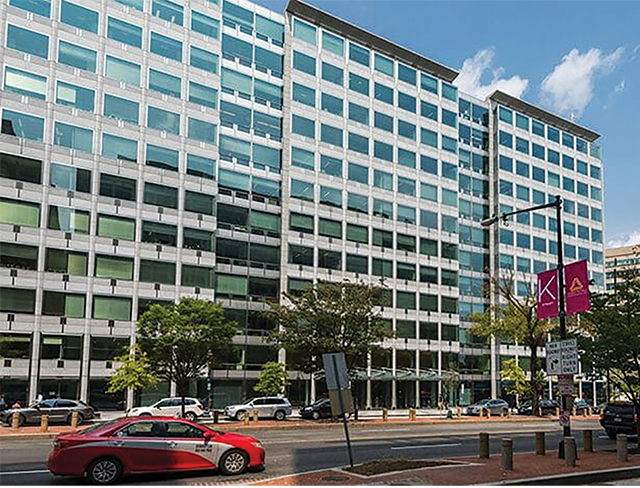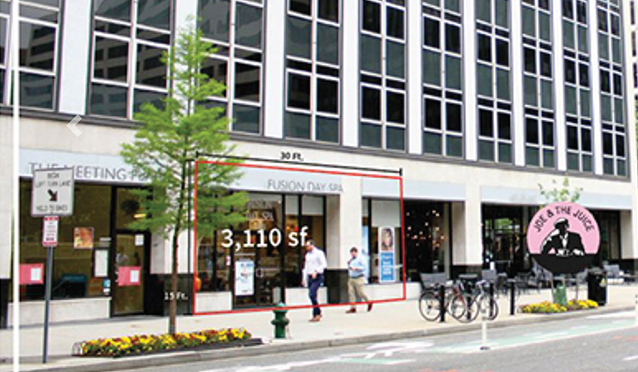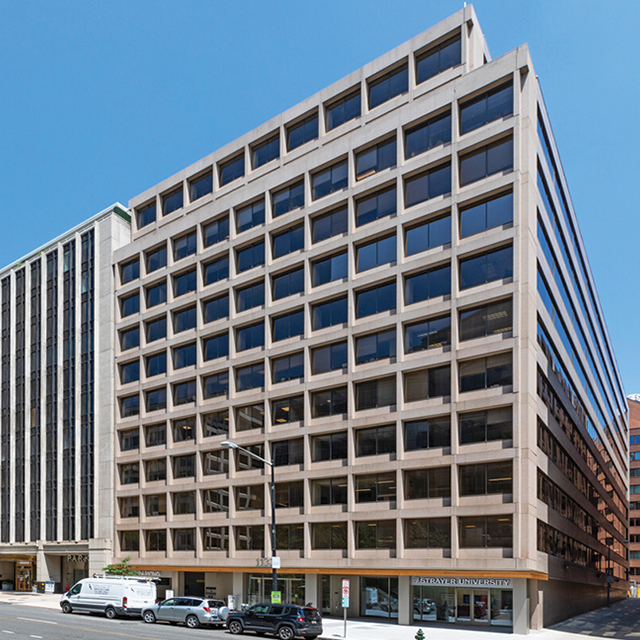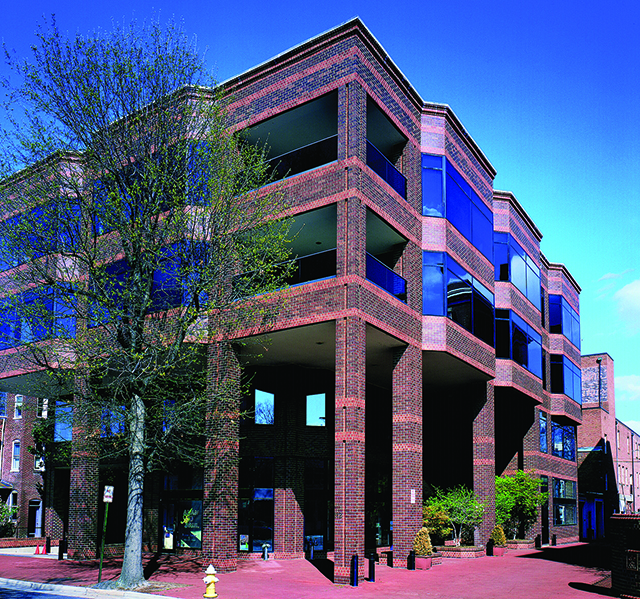1982
AAMFT moved to the District of Columbia (D.C.) from California. The historic move marked AAMFT’s next phase of organizational development and a shift in strategic direction to expand AAMFT’s federal advocacy efforts. At that time, the most effective method for federal advocacy was to have proximity to the U.S. Capitol with a physical address in DC rather than to remain on the west coast in California.
AAMFT moves into its first D.C. offices on K St. Space was close to two metro lines allowing easy access for new staff being hired from D.C., Maryland, and Virginia. Served as a good starting point for AAMFT’s D.C. operations.

1717 K Street
1984
An electrical fire in AAMFT’s space necessitates a move to a temporary space a few blocks away. After office space is rebuilt, AAMFT returns to the office on K St.
1989
Significant changes in AAMFT’s operations necessitated a new look at our real estate for better alignment with business goals. Growth of in-person meetings related to the Foundation, COAMFTE, and AAMFT governance meetings combined with increased staff necessitated a real estate analysis to find a new space to align more closely with AAMFT’s business needs.
1990

1100 17th Street
AAMFT leases new space on 17th St. in D.C.
The new space featured a larger conference room and kitchen area to accommodate the increased meetings. Filing space was increased to accommodate the growing number of paper files since the bulk of communications, project work, and transactions were in paper format.
Several years into the lease, AAMFT secured additional space in the building on another floor to accommodate the expansion of the Foundation which included hiring more staff.
1994
Once again, significant changes in AAMFT’s operations necessitated a new look at our real estate for better alignment with business goals. A complex time for AAMFT was starting: A new Executive Director was hired, the Foundation development project was faltering, and a large financial loss was projected for both AAMFT and the Foundation. This crisis led to a large lay-off of approximately 20 people, bringing the number of employees to about 30. This time also marked the shift to policy governance and simplification of the governance structure eliminating the need for many of the weekend governance meetings hosted in the office.
A real estate analysis was conducted, and it was determined that AAMFT would save significantly on rent over the next 11 years by securing new office space with reduced square footage and buying out the existing lease versus attempting to sublease the existing space.
1995
AAMFT secures a smaller space with less rental cost on 15th St. in D.C. With less in-person meetings occurring, this space shift focused on maximizing employee performance with more individual offices with natural light and a larger eat-in kitchen area for breaks. A special area was built to accommodate AAMFT membership staff that would be the front line for calls.
Early 2000s

1133 15th Street
Business shifts necessitate AAMFT’s next real estate analysis. For the first time, the option of purchasing a building is added to the considerations. Driving factors for the next analysis included:
- Shift to electronic communications reduced need to be at the Capitol weekly.
- Ability to access the Capitol easily from suburbs in Maryland and Virginia.
- Equal distribution of staff living in D.C., Maryland, and Virginia.
- Plenty of staff transportation options (metro, bus, car/van pools, and driving).
- Growing number of employer laws and regulations and lack of clear guidance from D.C. government agencies on compliance.
- Growing corporate regulations and costs.
- Better purchase value and quality of buildings along with better appreciation value.
2002
AAMFT moves into its newly purchased building at 112 S. Alfred St. in Alexandria, VA. This purchase satisfied the goal to control costs, provide space for existing operations and staff, provide room to expand, and provide the organization with a “brand” for members. AAMFT’s name was placed on the building.

2002-2012
Adjustments to owning office space highlight key benefits and challenges.
Benefits:
- Successfully paid off the mortgage early. An important step to remove debt financing and eliminate the need to pay unrelated business income tax on a future sale of the building.
- Governance leaders, members, and visitors enjoyed visiting and meeting in the space.
- Staff enjoyed working in the office space and in Old Town.
- City property assessments showed the building was appreciating in value.
- Increased collaboration between team members due to open space seating
Challenges:
- Initial trouble maintaining a retail tenant.
- Original main tenant did not renew. A strong leasing market allowed us to secure a new tenant, but there were months without rental income, realtor commission for new lease, and a new buildout took 6 months to complete and cost $175k.
- Issues with the HVAC that resulted in high repair costs annually. HVAC system was upgraded costing $110k.
- Many costly repairs such as: new roof $50k, new fire pump $50k, new compressor, electrical issues, plumbing issues, leaking windows, etc.
- Updates needed to comply with building codes.
- Power issues from electric grid severely damaging expensive HVAC or equipment.
- Security issues.
- No garbage room requiring an agreement with the hotel next door to handle trash disposal.
- Dealing with the hotel as the buildings are tied together. Their lack of repair would often cause AAMFT’s fire alarms to trigger.
- Issues with use of the parking garage.
- AAMFT office design had many custom components that were expensive to repair.
- Need to maintain an additional land lot.
- Additional taxes due to renting space.
- Loss of interest income due to supporting the costs mentioned above.
2012-2019
AAMFT hires new CEO and adopts new strategic plan. This plan called for AAMFT to invest in developing new programs to restore relevancy to members and those in the MFT community in the U.S. AAMFT management continued to invest in repairing and upgrading the building to maintain Class A status to ensure the building could be sold at a maximum price if AAMFT needed to sell. This resulted in unsolicited offers to purchase the building. Some costly improvements included:
- Upgraded the elevator, $244k
- Planned upgrade (2020) to the HVAC, $300k
Because the Building does not generate annual revenue capable of affording these upgrades, AAMFT must loan the Property Corporation funds to complete each project. Due to the lack of revenue from the Building, AAMFT staff are also diverted away from AAMFT’s mission to manage the property and any necessary projects.
In 2018, AAMFT leadership identified that AAMFT would need to reassess the strategic importance of owning a building over the next five years. Leadership noted that AAMFT operations had changed significantly since purchasing the building.
One key change was the shift from paper transactions to electronic communications, electronic file storage, and online processing. This greatly reduced the physical space needed to store archival files.
Another key change was the shift to virtual governance meetings conducted over Zoom to reduce the number of face-to-face governance meetings needed.
While much had been done to improve employee retention, recruitment had grown more difficult. AAMFT continued to be challenged to keep pace with rising salaries and improved benefits of the private sector and trade associations in the area. Rising cost of living and commuting expenses added to the difficulty, particularly given AAMFT’s trend to hire younger employees that matured developmentally into leadership and management positions.
2020
The COVID-19 pandemic and its impacts on the financial, real estate, and employment markets necessitate an accelerated real estate analysis. AAMFT enlists key consultants to assist in this process.


